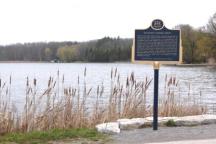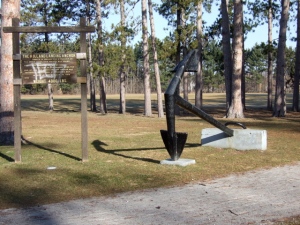 The war of 1812- the last war between US and Canada fought 200 years ago. Throughout parts of Ontario are a number of markers and sites relating to the war. Be it historical plaque, historic house or historic fort, each serves to mark significant events and battles fought in the frontiers of Upper Canada.
The war of 1812- the last war between US and Canada fought 200 years ago. Throughout parts of Ontario are a number of markers and sites relating to the war. Be it historical plaque, historic house or historic fort, each serves to mark significant events and battles fought in the frontiers of Upper Canada.
Queenston – the homestead of Laura Secord; Toronto – Fort York; Holland Landing… well Holland Landing, not the scene of any battle yet located here is a rather pronounced relic that is a direct link to the war of 1812. Tucked away in a park close to Yonge St in Holland Landing, is an enormous 4000 lb (1,814-kg) kedge anchor. Forged in England, the anchor was destined for a 36 gun ‘frigate’ to be built on Lake Huron. Now a two ton anchor is not your pocket size souvenir. Yet its great size conveys the fact that by 1813, both sides were engaged in an ambitious arms race of shipbuilding. Control of the Great Lakes meant an immense advantage in moving troops and supplies swiftly by water and each was looking to tip the balance in their favor. This would be in contrast, a slow drive by land. The distant roads of the day were sparse or none existent- largely undeveloped trails consisting of mud and swollen steams.
Boots, blankets, guns, ammunition, flour, and provisions, these were just a partial list of the great quantity of supplies for troops. Receiving these supplies was vital to British garrisons in defense of the remote northwest frontiers of Upper Canada at Mackinac Island on the western entrance to Lake Huron.
In September of 1813, the US gained control of Lake Erie for the remainder of the war. With this, the Holland Landing the northern most end of Yonge St, 34 miles (55 km) from York (Toronto) grew in importance as the principal depot in transshipping tones of heavy goods to the Upper Great Lakes to support the war.
Yonge St. developed rapidly during the war. Fortunately, nearly twenty years earlier, Governor Simcoe viewed the creation of Yonge St. north to the Holland River, as a strategic land link from Lake Ontario to Georgian Bay. He had established the building of Yonge St. recognizing the possible threat of American presence to block the Lake Erie trade route.
Hence lays the story of the anchor of Holland Landing. Built in the royal navy yards of England, it never served its intended capacity. In January of 1815, under urgent demands, the enormous anchor was hauled by sleigh from York to Holland Landing. Driven by sixteen yoke of oxen the anchor was moved with great difficulty over the course of four days to arrive at the Holland Landing Depot. By the time of its arrival here, the war of 1812 had ended, and the anchor was abandoned.
At the end of the war, military operations gradually moved from the Holland Landing Depot to the naval base at Penetangusihene. The government storage buildings at the Holland Landing fell into disuse and lay deserted by the 1830s. For over fifty years the anchor was left by the river. In 1870 it was brought from of the area of Soldiers Bay to the village park near the “Upper Landing” were it remains to this day. Mounted in “Anchor Park” it is curiosity that serves as a direct link to a critical time of the war when the security in Upper Canada was in question.
Additional Notes:
The Royal Navy Depot Holland Landing

The Royal Navy Holland Landing Depot played a significant role in the defense of Upper Canada. A historical plaque on the Holland Landing Depot was unveiled September 30, 2010, by the Ontario Heritage Trust and the Town of East Gwillimbury marking the site. It is located on the east branch of the Holland River at Soldiers Bay on the North side of Queensville Side Rd.
http://www.ontarioplaques.com/Plaques_VWZ/Plaque_York32.html
Anchor Park
 Anchor Park is located in Holland Landing at Doan Road east of Yonge St (Town of East Gwillimbury). The municipal park includes picnic shelter, soccer, baseball and playground facilities. It is adjacent of the Holland Landing Conservation Area with a series of hiking trails through tree plantations and forested areas.
Anchor Park is located in Holland Landing at Doan Road east of Yonge St (Town of East Gwillimbury). The municipal park includes picnic shelter, soccer, baseball and playground facilities. It is adjacent of the Holland Landing Conservation Area with a series of hiking trails through tree plantations and forested areas.
http://www.1812bicentennial.com/anchor-park.html
For locations follow this link:
http://www.waymarking.com/waymarks/WM4J08_Holland_Landing_Anchor_Anchor_Park_Holland_Landing_Ontario
My Brock ancestor was in the party that abandoned the anchor. I apologize on his behalf.
LikeLike
Ah…can you come pick it up?
LikeLike
I am told that my great-great-grandfather is as part of the group who brought the anchor to the park. He was a blacksmith in the landing, at what I believe was Samuel Lount’s smithy. Family story.
LikeLike
Thank you for your comment.
“The anchor reached the lower landing by the assistance of 16 yoke of oxen”
That’s a lot of oxen!
LikeLike